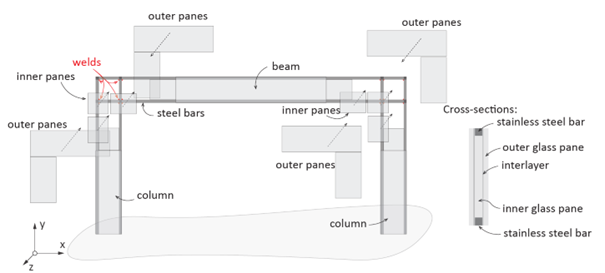Numerical Study of the In-Plane Bending Behaviour of a Novel Steel-Reinforced Glass Frame Prototype
DOI:
https://doi.org/10.47982/cgc.9.542Downloads

Abstract
In contemporary architecture, there is a growing emphasis on structural transparency, often leading to the consideration of design solutions that incorporate complete structural systems made from materials such as structural glass. While glass is typically fragile and exhibits elastic deformations under normal loads during its service life, unforeseen events can cause glass breakage. Load redistribution requirements at the member and system level can be crucial in preventing potential structural collapse. A new method for connecting beam components was developed in (Martens, 2018), with a focus on ensuring structural safety for both individual components and the overall system. This method improves transparency and preserves a seamless visual appearance of the statically indeterminate beam through the utilization of Cast-In-Place (CIP) bonding technology. CIP bonding technology permits on-site lamination, offering a solution for installing large laminated glass components in locations challenging to be reached and accommodating sizes that exceed the dimensions of standard production and transportation capabilities. This paper places particular emphasis on the numerical study of the in-plane behaviour of a novel steel reinforced glass frame prototype conceived to be (partly) constructed using UV-curable beam-column connections. For that purpose, a series of non-linear 3D Finite Element (FE) simulations is performed in Abaqus. Specified interlayer properties used in the simulations relate to SentryGlas®, which is used for beams and columns, whereas UV-curable resin is used for beam-column connections. Sensitivity analyses are performed assuming various stiffnesses of the UV-curable resin. The numerically simulated behaviour of the novel frame prototype is compared to the experimental results of an equivalent simply supported beam. The results indicate that the effect of the considered beam-column connections can significantly enhance the load-carrying capacity of the steel-reinforced glass frame system.
Published
Issue
Section
Experimental & Numerical Investigations
License
Copyright (c) 2024 Mirko Pejatovic, Robby Caspeele, Jan Belis

This work is licensed under a Creative Commons Attribution 4.0 International License.



